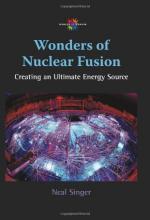|
This section contains 481 words (approx. 2 pages at 300 words per page) |

|
Nuclear reactions, highly energetic processes involving subatomic particles found within the nuclei of atoms, exist in two general forms. Fission reactions involve the splitting of atomic nuclei into smaller subatomic particles, in the process releasing relatively large amounts of energy. Fission chain reactions are responsible for the massive explosions of the atomic bombs that were employed during World War II. The second variety, fusion reactions, accomplish just the opposite.
Fusion reactions create larger atoms from the nuclei of smaller atoms. Here, when the nuclei of two or more atoms collide with sufficient force, they fuse to form a single, larger nucleus. During the fusion process, part of the mass of the fused nucleus is converted into energy. The energy produced is then released as heat, light, and various forms of radiation. Such nuclear reactions require extremely high temperatures to induce the necessary collisions. Critical temperatures for...
|
This section contains 481 words (approx. 2 pages at 300 words per page) |

|


